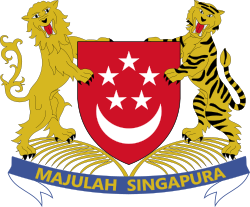| Coat of arms | Duration | Political entity | Description | Notes |
|---|
 | 1826–1942, 1945–1946 | Coat of arms of the Straits Settlements | Shield: Quarterly, the first quarter gules, issuant from the base a tower proper, on the battlements thereof a lion passant guardant Or; the second quarter argent, on a mount an areca nut palm tree proper; the third quarter also argent a sprig of the oil tree keruing proper; the fourth quarter azure in base on waves of the sea in front of a representation of the sun rising behind a mountain, a sailing yacht in full sail to the sinister, all proper. Crest: A demi-lion rampant guardant supporting in the paws a staff proper, thereon flying to the sinister a banner azure, charged with three imperial crowns Or. | The "first quarter gules" containing a lion on a tower represented Singapore. |
 | 1946–1959 | Coat of arms of the Colony of Singapore | Shield: Gules, issuant from the base a tower proper, on the battlements thereof a lion passant guardant or. Crest: A demi-lion rampant guardant supporting in the paws a staff proper, thereon flying to the sinister a banner argent, on a pall reversed gules, an imperial crown or. | Used when Singapore was a Crown colony. |
 | 1948 | Coat of arms of the Colony of Singapore | Shield: Gules, a tower issuant from the base proper; on the battlements thereof a lion passant guardant or; on a chief embattled of the last a pair of wings conjoined in base between two anchors azure Crest: on a wreath argent and azure on front of a palm tree fructed proper, issuant from a mount vert, a lion passant or. Motto: MAJULAH SINGAPURA (Onward Singapore) [1] | Used when Singapore was a Crown colony. This was granted by letters patent of 9 April 1948, and replaced after five months. |





